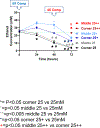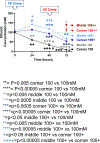Establishment of a Simple and Versatile Evaporation Compensation Model for in vitro Chronic Ethanol Treatment: Impact on Neuronal Viability
- PMID: 37981908
- PMCID: PMC10655227
- DOI: 10.3390/neuroglia3020004
Establishment of a Simple and Versatile Evaporation Compensation Model for in vitro Chronic Ethanol Treatment: Impact on Neuronal Viability
Abstract
Alcohol overconsumption is a major cause of preventable mental disorders and death in the United States and around the world. The pathogenesis of alcohol dependence, abuse, and toxicity to the central nervous system remains incompletely understood. In vitro and cell culture-based models have been highly valuable in studying the molecular and cellular mechanisms underlying the contribution of individual CNS cell types to ethanol's effects on the brain. However, conventional cell culture model systems carry the inherent disadvantage of rapid loss of ethanol due to evaporation following a bolus addition at the start of the treatment. We have established a multi-well cell culture plate-based ethanol evaporation compensation model that utilizes the inter-well space as a reservoir to compensate for the evaporative loss of ethanol in the cell treatment wells. Following a single bolus addition at the start of the treatment, ethanol concentration rapidly decreased over time. Through compensation using the multi-well plate platform, maintenance of ethanol concentrations ranging from 10-100 mM was achieved for up to 72 hours in a cell-free system. Greater effects in ethanol-induced decrease in neuronal cell viability were observed with than without compensation. Our method effectively compensates for the evaporative loss of ethanol typically observed in the traditional method. This method provides an economic, simple and effective in vitro model system for ethanol treatment over an extended timeframe where maintenance of a relatively constant concentration of ethanol is desired.
Keywords: cell culture model; chronic; compensation; ethanol; evaporation; neurons; viability.
Conflict of interest statement
Conflicts of Interest: The authors declare no conflict of interest. The funders had no role in the design of the study; in the collection, analyses, or interpretation of data; in the writing of the manuscript, or in the decision to publish the results.
Figures





Similar articles
-
Role of microglia in ethanol's apoptotic action on hypothalamic neuronal cells in primary cultures.Alcohol Clin Exp Res. 2010 Nov;34(11):1835-42. doi: 10.1111/j.1530-0277.2010.01271.x. Alcohol Clin Exp Res. 2010. PMID: 20662807 Free PMC article.
-
Calcium-mediated repression of β-catenin and its transcriptional signaling mediates neural crest cell death in an avian model of fetal alcohol syndrome.Birth Defects Res A Clin Mol Teratol. 2011 Jul;91(7):591-602. doi: 10.1002/bdra.20833. Epub 2011 May 31. Birth Defects Res A Clin Mol Teratol. 2011. PMID: 21630427 Free PMC article.
-
Effects of moderate alcohol consumption on the central nervous system.Alcohol Clin Exp Res. 1998 Aug;22(5):998-1040. doi: 10.1111/j.1530-0277.1998.tb03695.x. Alcohol Clin Exp Res. 1998. PMID: 9726269 Review.
-
Ethanol-induced death of postnatal hippocampal neurons.Neurobiol Dis. 2002 Aug;10(3):396-409. doi: 10.1006/nbdi.2002.0523. Neurobiol Dis. 2002. PMID: 12270700
-
GSK3beta in ethanol neurotoxicity.Mol Neurobiol. 2009 Oct;40(2):108-21. doi: 10.1007/s12035-009-8075-y. Epub 2009 Jun 9. Mol Neurobiol. 2009. PMID: 19507062 Free PMC article. Review.
References
Grants and funding
LinkOut - more resources
Full Text Sources
